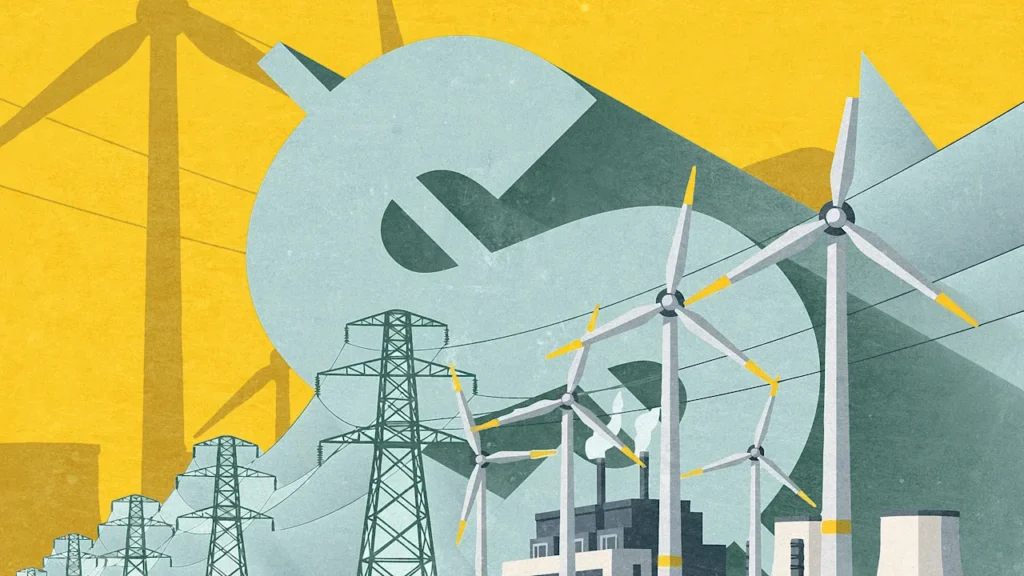
As electric bills keep soaring, Trump has tried to blame clean energy for the higher prices. But new research suggests the public isn’t buying it—and that clean energy could soon own the affordability argument.
A new briefing from the nonprofit Potential Energy Coalition looks at how to talk about clean energy in the middle of a cost-of-living crisis, when some advocates have suggested talking less about climate change as a reason to move away from fossil fuels.
Renewable energy is, however, the cheapest form of power—and many people recognize this. In a survey of more than 15,000 Americans, the nonprofit found that 38% already recognize that clean energy is cheaper than fossil fuels. Another 15% think that they cost the same, while 20% say that they don’t know. Fewer than a third think that fossil-fueled power has a cost advantage. (When asked an open-ended question about what’s causing the surge in energy bills, only 2% mentioned clean energy; the majority blamed corporate greed and politics, followed by weather and inflation.)
“Cost-of-living concerns are viewed by many elites as an obstacle to talking about clean energy—as a reason to run away or change the topic,” says Will Howard, head of insights and advisory services at Potential Energy Coalition. “But the reality is, shying away from the topic is the last thing we should do. Plenty of people already see the cost benefits of clean energy—and with the right message, many more do, too.”
The group tested various messages, including one that talked about rising demand for energy and the fact that clean sources are most affordable way to get it. After seeing that message, the belief that clean energy is cheaper than fossil fuels jumped up by 27 points.
“Our messaging in the test was able to significantly increase the perception, which I think speaks to the fact that while there may historically be a green premium that people perceive, a really large amount of this is pretty movable,” says Howard. “People don’t come to this with a really firm understanding or a high level of confidence of their own understanding of the issue, and it’s fairly malleable. If you show them the right message, they can actually shift the way they’re thinking about these energy sources and the costs associated with them.”
The nonprofit also tested messages about climate. Since Trump’s election, both business and politicians have moved away from talking about climate change. Some climate startups quickly pivoted to rebrand their products as focused on national security. A recent Searchlight Institute report suggested that the first rule in solving climate change is “don’t say climate change.”
But Potential Energy Coalition’s research suggests that climate messages were equally effective, and respondents in their surveys were still as concerned about climate as they had been in the past. “If you’re looking at how much did you persuade people to take action on climate, or how much did you persuade people to transition to clean energy—those two metrics specifically—a message about the urgent consequences of climate change is just as effective or more effective than talking about affordability,” says Howard.
The research suggests climate advocates should weave in key attributes that resonated in the tests, including the fact that clean energy is local, unlimited, and proven. One mistake, Howard says, is that some messages talk about clean energy as new or innovative—solar and wind power have been around for decades.
“There’s a price tag that comes with being new, and it’s [also] the opposite of proven,” he says. “What we saw in the testing is that being proven—we’ve been trying to do solar for 50 years or more—and the fact that prices have come down so much over the last 25 years on these clean energy sources, is actually much more reassuring and drives affordability perception much more.”
Another challenge is that people sometimes balk at the idea of building new infrastructure because of the upfront costs. But because of the surge in demand for new power, the choice isn’t between building renewables or just leaving fossil plants in place—it’s building renewables or adding more fossil fuels that have volatile, increasing costs. “The first step is getting them out of that binary and leveling the playing field of like, okay, hold on, we have to build something. So what should we build?” he says.
The nonprofit, founded by a former corporate marketing executive who wanted to help tackle the problem of climate change, sees clean energy as a brand—not in the traditional sense of a company’s brand, in the sense that the phrase “clean energy” evokes a certain feeling and a shared public understanding. That brand is strong, Howard says.
“The clean energy brand is better than we think, and it’s easy to strengthen it further if we’re disciplined about emphasizing the right attributes,” he says. “Specifically, not being afraid to position clean energy as the cheaper, better choice because it’s local, an unlimited resource, and a proven technology.”